- Spring loaded for optimum contact mating force
- High frequency performance
- Low VSWR
- Size 8: 1.15:1 Typ Mated Pair (DC to 26.5 GHz)
- Size 12: 1.25:1 Typ Mated Pair (DC to 26.5 GHz)\
- 1.5:1 Typ Mated Pair (26.5 - 40 GHz)
- Insertion Loss:
- 0.15 dB to 26.5 GHz Typ (Size 8)
- 0.2 dB to 40 GHz Typ (Size 12)
-

Is it really that hard to improve chip test performance?
In the digital era, semiconductor chips are present in almost every aspect of our lives. Whether it is from microwave ovens to computers, cell phones, computer central processing units, and other electronic devices there are a variety of chips installed.
-

Rethinking Blind Mate Connectors to Increase Reliability in Miniaturized Electronics Assembly
Creating more compact electronic components with higher functionality is a challenge for all electronics manufacturers. Whatever industry you're in, creating consumer, business, or military-grade electronics, the challenge presents itself, and the stakes are high. As electronics are expected to continue shrinking while increasing capabilities, blind mating connectors are required to meet those same size and functionality requirements.
-

Smiths Interconnect expands DaVinci test socket offering
The request for increased functionality in the smallest possible footprint has led to a reduction of the pitch of integrated circuits below 500 μm. At the same time, increased performances in SoCs affect pin-to-pin noise or what is commonly called crosstalk during testing.
-

Optimizing Production Test of QFN-packaged IC’s for Consumer, Automotive, Industrial and Power Applications.
Where best-in-class electrical requirements intersect with a need for a small outline, low-profile footprint, IC designers are increasingly migrating to QFN packages. Meeting these testing challenges requires a test socket solution that is robust, reliable, and electrically “clean.”




-2.jpg)